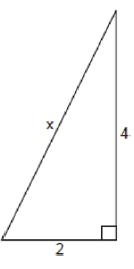SIMPLIFYING RADICALS
To simplify radicals, we have to be aware of operations of radicals.
How to add or subtract radicals ?
Like radicals can be added or subtracted.
√a + 2√a = 3√a
2√a - √a = √a
How to multiply or divide radicals ?
√a √b = √(a x b)
√a √a = a
√a /√b = √(a / b)
- If we have composite number inside the radical sign, we have to decompose it as much as possible until we receive prime number at the end.
- If we have square root, for every two same values we can take one value out.
- If we have cube root, for every three same values, we can take one out of it.
Problem 1 :
What is √32 expressed in simplest radical form ?
1) 16√2 2) 4√2 3) 4√8 4) 2√8
Solution :
√32 = √(16 × 2)
= √(4 × 4 × 2)
= 4√2
Hence, √32 expressed in simplest radical form is 4√2.
So, option 2) is correct.
Problem 2 :
The expression √50 can be simplified to
1) 5√2 2) 5√10 3) 2√25 4) 25√2
Solution :
√50 = √(25 × 2)
= √(5 × 5 × 2)
= 5√2
So, option 1) is correct.
Problem 3 :
What is √72 expressed in simplest radical form ?
1) 2√18 2) 3√8 3) 6√2 4) 8√3
Solution :
√72 = √(36 × 2)
= √(6 × 6 × 2)
= 6√2
Hence, √72 expressed in simplest radical form is 6√2.
So, option 3) is correct.
Problem 4 :
When √72 is expressed in simplest a√b form, what is the value of a ?
1) 6 2) 2 3) 3 4) 8
Solution :
√72 = √(36 × 2)
= √(6 × 6 × 2)
= 6√2
So, a is 6 and b is √2 . Then, the value of a is 6.
So, option 1) is correct.
Problem 5 :
The expression √150 is equivalent to
1) 25√6 2) 15√10 3) 5√6 4) 6√5
Solution :
√150 = √(25 × 6)
= √(5 × 5 × 6)
= 5√6
Hence, the expression √150 is equivalent to 5√6.
So, option 3) is correct.
Problem 6 :
When 5√20 is written in simplest radical form, the result is k√5. What is the value of k ?
1) 20 2) 10 3) 7 4) 4
Solution :
5√20 = 5√(5 × 4)
= 5 × 2 × √5
= 10√2
Hence, the value of k is 10.
So, option 2) is correct.
Problem 7 :
What is 2√45 expressed in simplest radical form ?
1) 3√5 2) 5√5 3) 6√5 4) 18√5
Solution :
2√45 = 2√(9 × 5)
= 2√(3 × 3 × 5)
= 2 × 3√5
= 6√5
Hence, 2√45 expressed in simplest radical form is 6√5.
So, option 3) is correct.
Problem 8 :
Which expression is equivalent to 7√90 ?
1) 16√10 2) 21√10 3) 70√10 4) √630
Solution :
7√90 = 7√(10 × 9)
= 7√(3 × 3 × 10)
= 7 × 3√10
= 21√10
Hence, the expression 21√10 is equivalent to 7√90
So, option 2) is correct.
Problem 9 :
What is 3√250 expressed in simplest radical form ?
1) 5√10 2) 8√10 3) 15√10 4) 75√10
Solution :
3√250 = 3√(25 × 10)
= 3 × √(5 × 5 × 10)
= 3 × 5√10
= 15√10
Hence, 3√250 expressed in simplest radical form is 15√10.
So, option 3) is correct.
Problem 10 :
What is √32/4 expressed in simplest radical form ?
1) √2 2) 4√2 3) √8 4) 8√2
Solution :
√32/4 = √(16 × 2)/4
= (√(4 × 4 × 2)/4
= (4 × √2)/4
= √2
Hence ,√32/4 expressed in simplest radical form is √2.
So, option 1) is correct.
Problem 11 :
Simplify : √12
Solution :
√12 = √(4 × 3)
= √(2 × 2 × 3)
= 2√3
Problem 12 :
Simplify : √75
Solution :
√75 = √(25 × 3)
= √(5 × 5 × 3)
= 5√3
Problem 13 :
Simplify : √128
Solution :
√128 = √(64 × 2)
= √(8 × 8 × 2)
= 8√2
Problem 14 :
Simplify : 3√27
Solution :
3√27 = 3√(9 × 3)
= 3√(3 × 3 × 3)
= 3 × 3√3
= 9√3
Problem 15 :
Express -3√48 in simplest radical form.
Solution :
-3√48 = -3√(16 × 3)
= -3√(4 × 4 × 3)
= -3 × 4√3
= -12√3
Problem 16 :
Express 5√72 in simplest radical form.
Solution :
5√72 = 5√(36 × 2)
= 5√(6 × 6 × 2)
= 5 × 6√2
= 30√2
Problem 17 :
Express 4√75 in simplest radical form.
Solution :
4√75 = 4√(25 × 3)
= 4√(5 × 5 × 3)
= 4 × 5√3
= 20√3
Problem 18 :
Express 2√108 in simplest radical form.
Solution :
2√108 = 2√(36 × 3)
= 2√(6 × 6 × 3)
= 2 × 6√3
= 12√3
Problem 19 :
Theo determined that the correct length of the hypotenuse of the right triangle in the accompanying diagram is √20. Fiona found the length of the hypotenuse to be 2√5. Is Fiona ‘ s answer also correct ? justify your answer.

Solution :
(AC)2 = (AB)2 + (BC)2
x2 = (2)2 + (4)2
x2 = 4 + 16
x2 = 20
x = √20
x = √(4 × 5)
x = 2√5
Yes she is correct.
Recent Articles
-
Finding Range of Values Inequality Problems
May 21, 24 08:51 PM
Finding Range of Values Inequality Problems -
Solving Two Step Inequality Word Problems
May 21, 24 08:51 AM
Solving Two Step Inequality Word Problems -
Exponential Function Context and Data Modeling
May 20, 24 10:45 PM
Exponential Function Context and Data Modeling